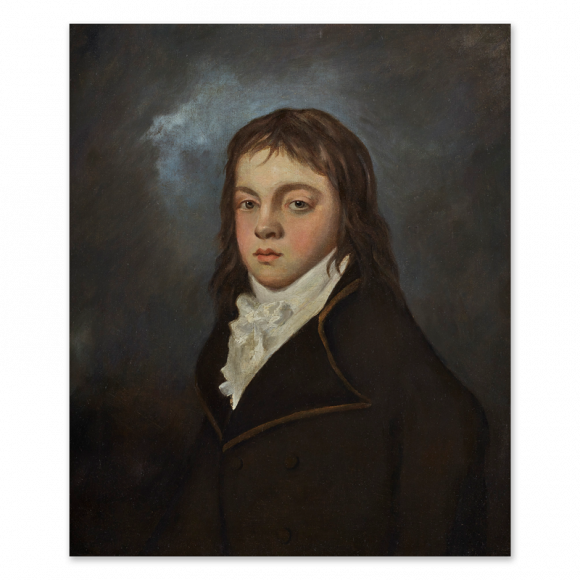A good carved and giltwood 18th century ‘Maratta’ style frame
The Earl of Southesk
Sotheby’s London, Southesk Sale, 21st June 1950
With Leggatt Bros, London, 1951
Sir Harold Parkinson KBE of Hornby Castle, Lancaster
Christie’s London, 20th June 1969 lot 71
With Spink & Son, 1971
Private Collection, USA
Tate Gallery, London ; Morland Exhibition, 1942
Islington Public Library ; Morland Memorial Exhibition, Jan 1945
Bankfield Museum Halifax ; Halifax Centenary Celebrations, 1948
Henry Morland carved out a recognizeable niche for himself as British 18th century artist.He was a thoroughly competent portrait painter and was known as a copyist as well.But his reputation rests today on a charming series of what came to be known as ‘fancy pictures’.These typically were scenes of everyday life with an element of the imagination about them.Morland’s preferred subjects were young women engaged in everyday tasks; laundresses, oyster sellers, ballad-singers and the like.In all of these pictures there is an idealized element, where a certain sentimentality tends to disguise the everyday hardships of such roles in reality.For all that, these subjects found a ready market amongst his upper and middle class patrons and were reproduced prolifically in editions of prints – usually mezzotints.
Henry Morland’s son, George Morland, was in his relatively short life-span to reach heights of popularity unknown to his father.Taught initially by his father he showed prodigious skill at a young age and was exhibiting at the Royal Academy as a teenager.But he had a character that strongly resisted any attempt at control and not only left his father’s studio, but refused any further instruction, even from an artist of the standing of George Romney.Along with this staunch sense of independence came a taste for riotous living and from his twenties onwards his extraordinary skill went hand in hand with an undeniable taste for dissolution and alcoholism.Remarkably, despite debilitating bouts of drunkenness, he managed until the mid 1790s to produce works of remarkable quality.
His first attempts on canvas were mostly studies of individual animals, but he soon picked up on the demand for pictures of the upper classes involved in their pursuit of refined entertainment. These he delivered with great panache. From the late 1780s until the early 1790s we can follow his choice of subject matter through the numerous engravings that were produced after his work.Here we see titles such as 'A Visit to the Boarding School,' 'Children Birdnesting,' 'Juvenile Navigation,' 'The Kite entangled,' 'Blind Man's Buff,' and 'Children playing at Soldiers.'Equally popular (and somewhat ironically for Morland) were scenes of moral contrast, like 'The Fruits of early Industry and Economy' (1789) and Effects of Extravagance and Idleness' (1794), or 'The Miseries of Idleness' and the 'Comforts of Industry,' both published in 1790.He even produced subjects appealing to national sentiment, like 'The Slave Trade' (1791) and its contrasting companion picture 'African Hospitality', which supported the abolitionist cause then growing in England.As the 1790s wore on these elegant and refined subjects gradually gave way to scenes from humble life in town and country, including the English coastline showing fishermen, smugglers and sporting scenes.Eventually he settled for depictions of the life of the cottage, the stable, and the inn-yard, with lively groups of men and women, and a cast of beautifully observed horses, donkeys, dogs, pigs, poultry, and other animals.
By the end of the 1790s though, George Morland’s life-style had caught up with him.A notorious drunk, he was at times unable to hold a palette and additionally found himself constantly on the run from his creditors.Hasty retreats to the Isle of Wight and to France followed, where when sober he could still paint lively landscapes and coastal scenes with well-drawn figures.But this last period is also peppered with numerous, poor ‘pot-boilers’, tossed off to placate landlords and other creditors.Some of these are indistinguishable from the many copies of his work by inferior hands, which had sprung up due to Morland’s popularity.Perhaps inevitably he died in a sponging-house – a kind of debtor’s prison - in 1804.An ignominious end for such a gifted artist.
This present picture by Henry Morland of his still quite young son is a charming rendition of a boy on the verge of adulthood.The National Portrait Gallery in London holds another picture by Henry Morland of his son George at an easel, which they date to 1779, making the sitter some 16 years of age.In our picture, Morland junior, clearly recognizeable by his similar facial features, must be younger by a couple of years – making him 13 or 14 years old.This would give us a date of 1776 or 1777 for our picture.
Knowing what we know about George Morland’s later life it is tempting to try and read into our sitter’s face some indication of the years to come.This is always dangerous territory.Perhaps we can just say that we can see here a young man, fashionably presented by his naturally proud and ambitious artist- father.But along with that elegance is possibly also on view a slight hint of the sullen-ness of the gifted son – a indication of the determined character which would launch him to considerable fame and also to his unfortunate end.However we read it, this is a picture of some significance.George Morland will always have his place in English art-history.And here we have the opportunity to see what this notable painter looked like as he stood on the verge of adulthood – and on the verge of that phenomenal development, which would make him briefly one of the most popular painters in Regency England.




